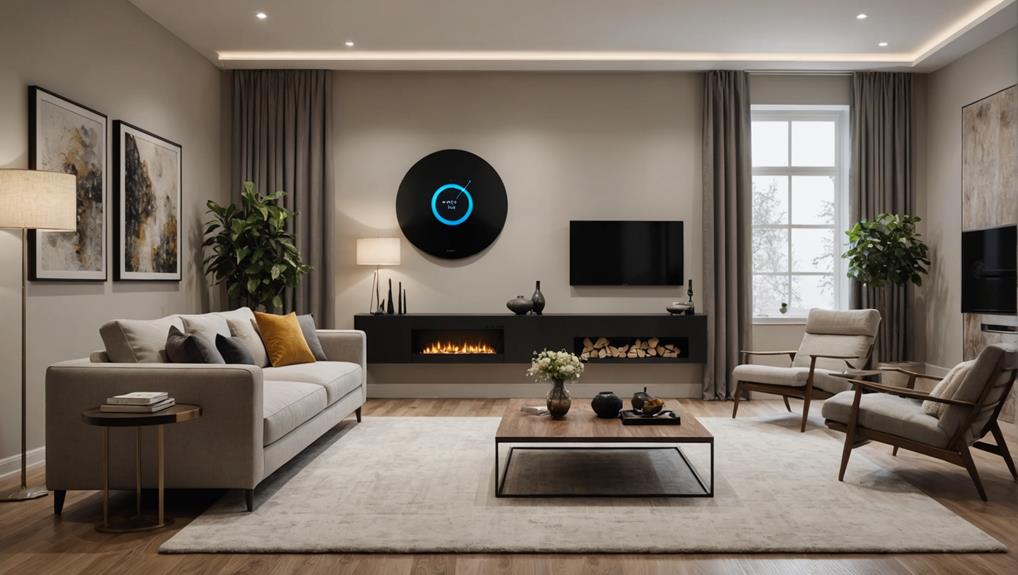Heated flooring systems work well with smart thermostats, enhancing your comfort and energy efficiency. To guarantee compatibility, check that your thermostat is designed for your specific heating type, whether electric or hydronic. Programmable and learning thermostats offer excellent features like scheduling and adaptive temperature controls. Proper installation is key, so consult wiring standards and consider sensor placement for peak performance. This integration not only provides consistent warmth but can also lead to significant energy savings. If you're curious about specific brands or installation tips, there's plenty more to explore on this topic.
Understanding Heated Flooring Systems
Heated flooring systems are becoming increasingly popular for homeowners seeking comfort and efficiency. These systems use electrical heat cables or hydronic tubes to warm your floors, providing a cozy environment, especially during colder months. When considering heated flooring, it's important to understand how they integrate with your existing heating systems and the role of floor insulation in maximizing their effectiveness.
When you install a heated floor, proper floor insulation is vital. Insulation helps retain heat, ensuring that it radiates into your living space rather than being lost downward. Without adequate insulation, you might find that your heating systems are working harder than necessary, leading to increased energy costs. Insulated floors not only enhance comfort but also improve energy efficiency, making your system more cost-effective in the long run.
Moreover, heated flooring can be a safer choice, especially in homes with children or elderly family members. Unlike traditional heating methods, heated floors eliminate the risk of hot surfaces or exposed heating elements, reducing the likelihood of burns or accidents.
Types of Smart Thermostats
When choosing a smart thermostat, you'll encounter two main types: programmable and learning thermostats. Programmable models allow you to set specific schedules for temperature adjustments, while learning thermostats adapt to your habits over time. Understanding these features helps you select the right option for ideal comfort and energy efficiency in your heated flooring system.
Programmable Smart Thermostats
Programmable smart thermostats have become essential tools for homeowners seeking to optimize energy efficiency and enhance comfort. These devices allow you to create programmable schedules tailored to your lifestyle, guaranteeing that your heated flooring operates only when you need it. By setting specific heating times, you can maintain a cozy environment while minimizing energy consumption.
One of the primary advantages of programmable smart thermostats is the potential for significant energy savings. When you program your thermostat to lower the temperature during hours you're away or asleep, you reduce unnecessary heating. This not only lowers your energy bills but also contributes to a more sustainable household.
Safety is another consideration; many programmable thermostats come equipped with features that monitor the system, alerting you to any irregularities that could indicate a malfunction. This proactive approach helps guarantee your home remains a safe haven.
Learning Thermostat Features
Smart thermostats come in various types, and one of the most innovative categories is the learning thermostat. These devices have advanced learning capabilities that allow them to adapt to your heating preferences over time. By analyzing your daily routines, they create a personalized schedule that optimizes energy efficiency while ensuring your home remains comfortable.
When you first install a learning thermostat, it might take a few days to gather enough data. However, once it's familiar with your habits, it adjusts temperatures automatically based on when you're home or away. This feature not only enhances comfort but also promotes energy savings, which can contribute to lower utility bills.
The user interface on these thermostats is typically intuitive and user-friendly, allowing you to monitor and control your heating system effortlessly. Many models come with smartphone apps, giving you remote access to your home's heating settings, which is essential for maintaining safety and efficiency.
Compatibility Factors to Consider
Before diving into the installation of heated flooring and smart thermostats, it is vital to sort out compatibility factors that can impact performance and efficiency. Here's what you need to take into account to guarantee a seamless integration.
- Heating Zones: Determine if your heated flooring system can accommodate multiple heating zones. This flexibility allows you to control temperature settings in different areas of your home, enhancing comfort and energy savings.
- Smart Integration: Verify that your smart thermostat supports communication with your specific heating system. Not all thermostats can manage heated floors, so check the manufacturer's guidelines.
- Temperature Control: Look for thermostats that offer precise temperature control, making sure your heated flooring maintains a consistent warmth.
- User Interface: A user-friendly interface is significant. You want a thermostat that's easy to program and adjust, even remotely.
- System Efficiency: Both your heating system and thermostat should work together to maximize energy efficiency. This helps reduce installation costs in the long run.
- Remote Access: Confirm your thermostat allows for remote access. This feature enables you to adjust temperature settings from anywhere, providing convenience and peace of mind.
- Maintenance Tips: Choose a thermostat that provides maintenance alerts to help keep your system running smoothly.
Here's a quick summary in table format:
| Factor | Importance |
|---|---|
| Heating Zones | Enhances comfort and savings |
| Smart Integration | Compatibility assurance |
| Temperature Control | Consistent warmth |
| User Interface | Ease of use |
Electric vs. Hydronic Heating
When evaluating heated flooring systems, one of the most important decisions you'll face is choosing between electric and hydronic heating. Both options have their pros and cons, so it's essential to assess which suits your needs best. Here are three key factors to take into account:
- Energy Efficiency: Electric heating systems can be more efficient for smaller spaces, while hydronic heating excels in larger areas, especially where insulation is good.
- Installation Challenges: Electric systems are typically easier to install and may not require extensive renovations. Hydronic heating, on the other hand, can involve more complex installation, including plumbing work.
- Temperature Control: Electric heating offers quick and responsive temperature adjustments, while hydronic systems may take longer to heat up but provide consistent warmth.
In terms of cost comparison, electric heating often has lower upfront costs, but hydronic heating can be more economical in the long run, depending on your climate and usage patterns. Both systems require maintenance, but hydronic systems may need more attention to guarantee the pipes are functioning correctly.
Your choice may also depend on the types of flooring materials you prefer. Certain materials, like tile, work well with both systems, while others may have limitations. Finally, always take into account climate considerations and user preferences, as they can greatly influence your satisfaction with the heating system. By weighing these factors, you can make an informed decision that assures warmth and safety in your home.
Popular Smart Thermostat Brands
Thermostats have come a long way in recent years, with smart options leading the way in home automation and energy efficiency. If you're considering a smart thermostat for your heated flooring, you'll find several popular brands that stand out due to their features, compatibility, and user-friendly designs.
The Nest Learning Thermostat, part of the Google Nest line, is renowned for its adaptive learning capabilities, allowing it to adjust temperatures based on your habits. Similarly, the Ecobee SmartThermostat offers room sensors for precise temperature control, making it an excellent choice for homes with heated flooring.
Honeywell Home also provides reliable options, including the Honeywell Home T9, which can coordinate with various heating systems. Tado Smart thermostats are great for energy-saving features, automatically adjusting based on your location.
Emerson Sensi is another solid choice, boasting an easy-to-use interface and energy monitoring capabilities. The Lux Kono offers a customizable design, allowing you to match its appearance to your home. For those interested in advanced features, Netatmo Smart thermostats provide thorough climate analytics.
If you have electric heated flooring, consider the Mysa Smart thermostat, specifically designed for electric systems, guaranteeing peak performance. When selecting a thermostat, make certain it's compatible with your heating system to guarantee safety and efficiency. By choosing one of these popular brands, you can enjoy a comfortable home while maximizing energy savings.
Installation Requirements
When installing heated flooring and smart thermostats, you'll need to guarantee proper wiring connections and adhere to relevant standards. It's also vital to check thermostat type compatibility to prevent any operational issues. Additionally, sensor placement considerations can greatly impact the system's overall efficiency and performance.
Wiring Connections and Standards
Getting the wiring connections right is essential for the effective installation of heated flooring and smart thermostats. Proper wiring guarantees safety and peak performance, so you'll want to pay close attention to wiring standards and connection types. Here are three key points to take into account:
- Check Local Codes: Always verify your local electrical codes, as they dictate the wiring standards for heated flooring systems.
- Identify Connection Types: Understanding the different connection types—like low-voltage or line-voltage systems—can help you determine the correct approach for your installation.
- Use Quality Components: Investing in high-quality wiring and connectors can reduce risks and enhance the longevity of your system.
Make certain you follow these guidelines carefully. Incorrect connections could lead to malfunction or even hazards. It's advisable to consult with a licensed electrician if you're unsure about any aspect of the wiring process. By adhering to proper wiring standards, you'll not only guarantee the safety of your heated flooring installation but also enjoy the seamless integration with smart thermostats for efficient temperature control.
Thermostat Type Compatibility
Understanding the compatibility of your chosen thermostat with heated flooring systems is vital for a successful installation. Different types of thermostats come with varying features that can greatly affect their performance with radiant heat systems. For example, smart thermostats often have advanced programming capabilities and energy-saving options, but not all are designed to handle the specific requirements of heated floors.
When selecting a thermostat, check for features like floor-sensing capabilities, which can optimize heat distribution and improve comfort. Additionally, verify the thermostat can handle the load of your heating system; this is significant for safety and efficiency.
For installation, follow these tips: First, confirm that the thermostat is compatible with your specific heating system, whether it's electric or hydronic. Next, review the manufacturer's guidelines for wiring and setup, as improper installation can lead to safety hazards or system failure. Finally, consider professional installation if you're unsure about the process, as this can help avoid costly mistakes and guarantee your system operates safely and efficiently.
Sensor Placement Considerations
Proper sensor placement is essential for maximizing the performance of your heated flooring system. It guarantees accurate temperature readings and enhances system integration with your smart thermostat. Here are three key considerations to keep in mind:
- Sensor Types: Choose the right sensor type—programmable or non-programmable—based on your system's needs.
- Room Layout: Position sensors centrally within the room to capture uniform temperature readings, avoiding corners or areas with obstructions.
- Environmental Factors: Consider factors like sunlight exposure or drafts that could skew readings.
When implementing these placement strategies, remember the following installation tips: verify sensors are level, avoid placing them near heat sources, and regularly check for proper temperature calibration.
Additionally, understanding your room layout can help in deciding where to place sensors for peak performance optimization. By carefully planning sensor placement, you'll not only enhance the efficiency of your heated flooring but also guarantee a comfortable and safe environment. Following these guidelines will lead to a more effective integration between your heated flooring and smart thermostat, giving you peace of mind while enjoying the benefits of a warm floor.
Energy Efficiency Benefits
When it comes to energy efficiency, heated flooring combined with smart thermostats can greatly reduce your energy consumption. By optimizing heat distribution throughout your space, these systems guarantee that warmth is delivered evenly, which not only enhances comfort levels but also leads to significant energy savings. Smart thermostats allow you to program heating schedules based on your habits, guaranteeing that energy isn't wasted when you're not home.
The cost efficiency of heated flooring paired with smart technology can also be a game changer. While installation costs may initially seem high, the long-term savings on energy bills often offset these expenses. Plus, the lower maintenance requirements of heated flooring systems compared to traditional heating methods make them a more sustainable choice, reducing your environmental impact over time.
User satisfaction often increases as well, as many find the consistent warmth of heated flooring far superior to the sporadic heat of radiators or forced air systems. You'll enjoy a cozy environment without the drafty cold spots that can occur with other heating methods.
Troubleshooting Compatibility Issues
Even though heated flooring systems offer numerous benefits, compatibility issues can arise when integrating them with smart thermostats. You'll want to address these potential problems to guarantee your system works efficiently and safely. Here are some common issues you might encounter:
- Thermostat Type: Not all smart thermostats are designed for use with heated flooring. Make sure yours is compatible.
- Wiring Conflicts: Incorrect wiring can lead to malfunction. Double-check that the wiring adheres to both your thermostat and heated flooring specifications.
- Voltage Mismatch: Verify that the voltage of your heating system matches what your thermostat can handle to avoid damage.
When troubleshooting compatibility issues, consider these troubleshooting tips to help you get back on track:
- Review Manufacturer Guidelines: Always refer to the specifications laid out by both the heated flooring and smart thermostat manufacturers. They often provide detailed compatibility charts.
- Test Your System: After installation, perform a thorough test. Check for any irregularities in heating or thermostat response.
- Seek Professional Help: If you can't resolve the issue, don't hesitate to contact a professional. They can provide insights and solutions that guarantee safety and efficiency.
Future Trends in Smart Heating
As we look ahead, the evolution of smart heating systems is poised to revolutionize how we manage indoor climates. You're likely to see a significant shift toward enhanced smart home integration, where your heating systems will seamlessly connect with other smart devices. Imagine controlling your heating through voice commands or mobile apps, adjusting settings based on real-time data from your environment. This level of convenience can lead to increased energy efficiency and reduced utility costs.
Emerging technologies are also playing an essential role in this transformation. For instance, advancements in AI and machine learning will allow smart thermostats to learn your habits, optimizing heating schedules to fit your lifestyle while guaranteeing safety. They'll monitor your home for potential hazards, such as overheating or malfunctions, sending alerts directly to your smartphone to keep you informed.
Another exciting trend involves the integration of smart heating with renewable energy sources. As solar and wind technologies continue to advance, you'll find options that enable your heating systems to utilize clean energy, contributing to a more sustainable future.
Moreover, the rise of IoT (Internet of Things) will guarantee a more interconnected home. Your heating system will be able to communicate with your security system, enhancing safety by adjusting temperatures based on occupancy.
Frequently Asked Questions
Can I Control Heated Floors With a Smartphone App?
You might think controlling heated floors with a smartphone app is complicated, but it's actually quite straightforward. Many smart home systems allow for seamless integration, letting you adjust your floor heating from anywhere. This not only enhances comfort but also boosts energy efficiency by enabling you to schedule heating based on your lifestyle. Just guarantee you choose a reliable app that prioritizes safety, giving you peace of mind while enjoying your cozy home.
Do Smart Thermostats Require Wi-Fi for Heated Flooring?
Yes, smart thermostats generally require Wi-Fi for peak functionality, including when controlling heated flooring systems. During smart thermostat installation, verify your Wi-Fi network is reliable, as it allows remote access and adjustments through your smartphone. This connectivity enhances safety by enabling you to monitor and manage your heating systems from anywhere. If you're considering a smart thermostat, check compatibility with your specific heated flooring systems to verify seamless operation.
How Accurate Are Smart Thermostats With Heated Flooring?
When it comes to smart thermostats, think of them as the captains of your home's temperature ship, steering you toward comfort. Their accuracy largely hinges on quality temperature sensors, ensuring even warmth throughout your space. However, installation considerations are essential; improper placement can lead to false readings. For safety, always follow guidelines during installation to prevent overheating or damage, keeping your home cozy and secure without any worries.
Will Heated Flooring Affect My Smart Thermostat's Battery Life?
Heated flooring won't greatly affect your smart thermostat's battery lifespan. Most modern thermostats are designed to optimize energy efficiency, even with heated floors. While they may draw more power initially during heating cycles, the overall impact on battery life is minimal. You should still regularly check your thermostat's battery, as this guarantees safety and uninterrupted operation. Maintaining a charged battery will help you enjoy consistent comfort without concerns about performance.
Can I Use Multiple Smart Thermostats for One Heated Flooring System?
You can absolutely have multiple smart thermostats running a heated flooring system, but it's not as simple as pie. You might face compatibility issues depending on the models and systems you choose. Each thermostat should be capable of managing its designated zone properly. Make certain they're designed for multi-zone setups to maximize efficiency and safety. Always consult the manufacturer's guidelines for installation to avoid potential pitfalls and keep everything running smoothly.




